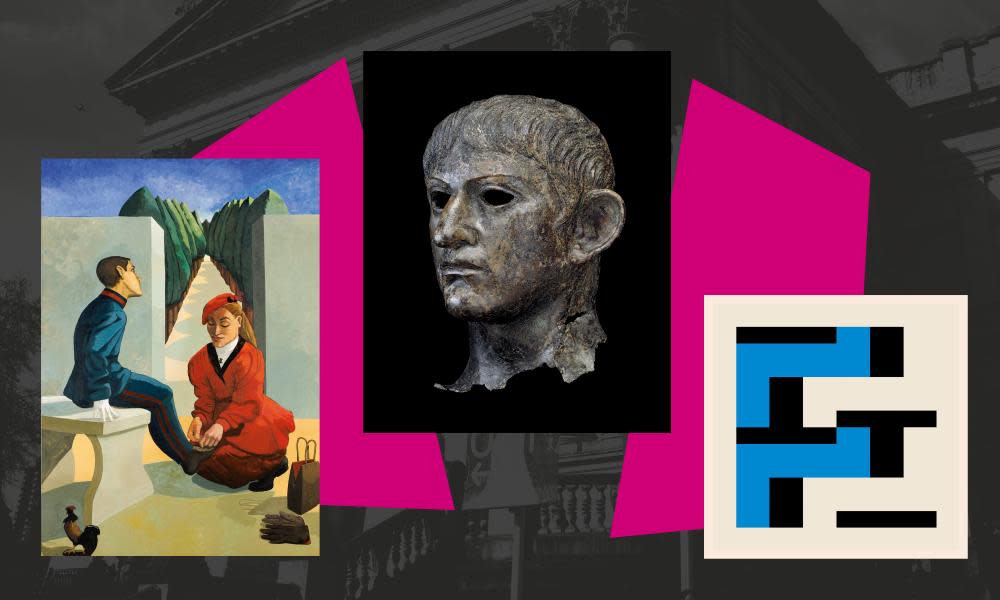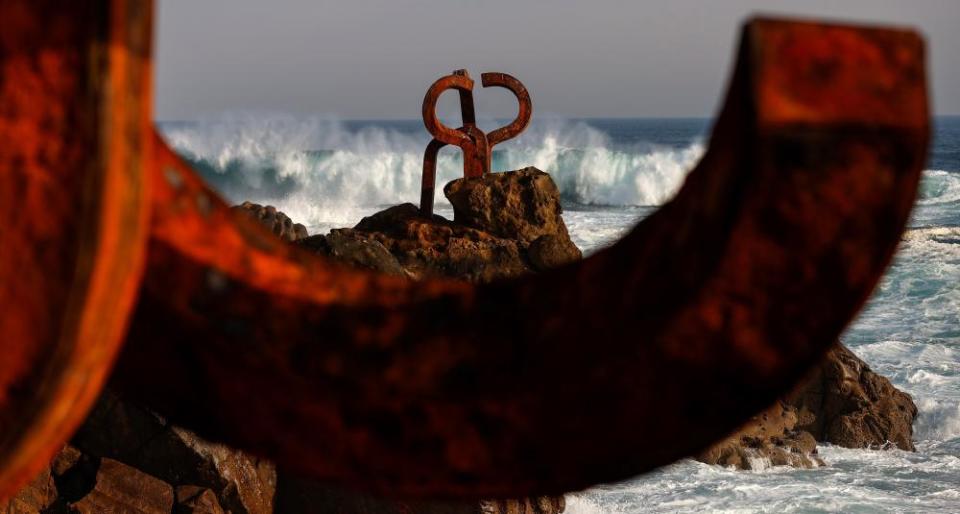From brutal Dubuffet to nice guy Nero: what to see as art exhibitions open

Jean Dubuffet: Brutal Beauty
Provocateur, founder of art brut, or raw art, Jean Dubuffet embraced the arbitrary and irrational, using crude materials and working with an ironic rejection of skill and finesse. Immersed in French intellectual and artistic life, the show focuses both on Dubuffet’s own work and on his extensive collection of outsider art. It’s the first major UK exhibition of this complex, fascinating artist in more than 50 years.
Barbican Art Gallery, London, 17 May-22 August.
Heather Phillipson
Phillipson’s Tate Britain Duveen commission follows her sagging ice cream cone, giant fly and a useless twirling drone on the fourth plinth. The sculptor and video artist makes work that churns with humour, autobiography, knockabout asides and a poet’s sense of the unlikely conjunction. Then there’s her cheery feel-bad factor, the uplift and the downside. Can’t wait.
Tate Britain, London, 17 May to 23 January.
The Making of Rodin
The Rodin Museum in Paris has lent scores of wondrous plaster models from the great symbolist’s studio to shape this flowing, abundant display of his endless creativity. There are erotic watercolours, too. Rodin’s imagination is revealed from the inside, as he enlarges a head to colossal size or casts an empty dressing gown, inventing surrealism as a by-product.
Tate Modern, London 18 May-21 November.
Veronica Ryan
Seed pods and volcanic ash are among the sources and materials that this British sculptor, born in Montserrat, uses to map the history of Alliouagana (as her birthplace was called by its original people, the Caribs, before the coming of Europeans). That ancient name means “land of the prickly bush”. It fits well with Ryan’s sensual, thought-provoking art.
Spike Island, Bristol, 19 May-5 September.
Liverpool Biennial 2021: The Stomach and the Port
The delayed 11th Liverpool Biennial thinks about the city as a body, a fluid organism that is continuously shaped by and shaping its environment. The curatorial premise talks about three entry points – the stomach, porosity and kin. Make of this what you can. There will be dance, music and all kinds of interdisciplinary shenanigans from a roster of international artists throughout the city. Pass the port.
Liverpool (citywide), 19 May-27 June
Matthew Barney: Redoubt
Including large-scale sculptures and etchings, Matthew Barney’s Redoubt has at its heart his latest and much acclaimed feature-length film in which he takes us hunting through the wintry landscape of Idaho’s Sawtooth mountains. Loosely based on the myth of Diana and Actaeon, the film explores the symbiotic relationship between hunter and prey, told via wondrous choreography and cinematography and set to a marvellous score by Barney’s long-time collaborator Jonathan Bepler. Barney can be devilishly obscure and strange, here gun fetishism, pursuit and waiting, art, nature and death collide.
Hayward Gallery, London, 19 May-25 July.
Eileen Agar
This British surrealist is one of those artists renowned for a single work – her feathery, silky, mysterious assemblage of a blindfolded head, Angel of Anarchy. This exhibition promises to dig deeper, revealing a great modern subversive. Even if her seashell collecting and avant-garde networking doesn’t convince you of that, a trip through 1930s eccentricity is bound to be fun.
Whitechapel Gallery, London, 19 May-29 August.
Alice: Curiouser and Curiouser
Lewis Carroll’s alternative universe has always demanded visual responses to its shifts of scale and surreal encounters. John Tenniel’s Victorian illustrations are masterpieces in themselves while Salvador Dalí and Jan Švankmajer are among the modern dreamers who crashed through the looking glass. This show isn’t just an art display: it promises an immersive wonderland.
V&A, London, 22 May-31 December.
Samson Kambalu: New Liberia
Responding to the pandemic and the Black Lives Matter movement, colonial history and Malawian modernism, Oxford-based Malawian artist Samson Kambalu (shortlisted for the next Fourth Plinth project) delves into Malawian history and autobiography in his often hilarious, touching and fiercely intelligent art. Using film and sculpture, Kambalu evokes a New Liberia of utopian racial justice.
Modern Art Oxford, 22 May-5 September.
Nero: The Man Behind the Myth
Was the notorious Roman emperor as bad as he’s painted? Blamed for persecuting Christians, burning Rome and performing some of the worst poetry of all time, this cruel would-be artist, as portrayed by the Roman writers Tacitus and Suetonius, is a prototype of the tyrant whose grotesque persona seems to echo in 20th-century dictators and even the occasional politician today. But apparently he was a lovely guy.
British Museum, London, 27 May-24 October.
Gustave Moreau: The Fables
One of the strangest and most fascinating French modern artists gets an overdue fresh look in Britain. Moreau’s late 19th-century visions of decadence are not only sensational in content – from erotic dances to grisly beheadings – but painted with a lavish experimental daring. His caked and bejewelled surfaces influenced the surrealists and still disconcert and entrance.
Waddesdon Manor, Aylesbury, 16 June-17 October.
Eduardo Chillida

Basque sculptor Eduardo Chillida is best known for his monumental sculpture The Comb of the Wind on the coastal rocks overlooking his home-town of San Sebastián. Influenced, among other things, by the Basque ironworking tradition and by his dialogues with the philosopher Martin Heidegger, by modernism and by his experience as a professional goalkeeper for Real Sociedad, just like a goalie, Chillida’s weighty art grabs at space.
Hauser & Wirth, Somerset, 26 June-3 January.
Sutapa Biswas: Lumen
A welcome survey at Kettle’s Yard in Cambridge (16 October-30 January) of the Bengal-born British Indian artist’s extensive career runs partly in parallel with a longer exhibition of her work at Baltic, Gateshead. Biswas often draws from myths and iconography from ancient Hindu mythologies, most famously in her Housewives With Steak-knives, a painting of the Tantric goddess Kali wearing a necklace of severed heads: politicians, Hitler, a European colonialist. Featuring painting, drawing, sculpture, photography and video.
Baltic, Gateshead, 26 June-20 March.
Afterness
Almost an artwork in their own right, the haunting landscapes and modern ruins of Orford Ness in Suffolk – where radar was invented and where there are weapons testing facilities from both world wars and for cold war tests on the ruggedness of nuclear bombs – are being reoccupied in a series of installations and sound works, sculpture, film and radio broadcasts. Artists, poets, house musicians and a members of Flock Together, a birdwatching collective for people of colour, insinuate themselves among Orford’s lowering nuclear testing pagodas, its secret histories and astonishing ecology.
From 1 July. For event days/times and ferry details, go to artangel.org.uk/project/afterness.
Paula Rego
An important exhibition by a remarkable artist. Rego paints fairytales for adults in a forceful, muscular style that hints at all manner of darkness. Violence, loss, desire and sorrow stalk her wordless narratives. She paints people with a grandeur reminiscent of Picasso’s classical period, and an eye for the appalling that leaves you wondering at what’s hidden in the ordinary.
Tate Britain, London, 7 July-24 October.
Karla Black
Edinburgh’s Fruitmarket Gallery reopens after a much-needed £3.5m expansion, doubling the gallery in size, with Scottish sculptor Karla Black, whose works since 2000, using ephemeral everyday materials – petroleum jelly, bath bombs, raw plaster and pigment, cellophane and polythene – make a mess of things, in a good way. Earlier work will be augmented by two new commissions in the new, stripped-back warehouse spaces.
Fruitmarket, Edinburgh, 7 July-21 November.
Rachel Kneebone: 399 Days
Tiny bodies swarm in orgiastic plenitude in Kneebone’s porcelain sculpture. Her white ceramic explosions of intertwining flesh are reminiscent of the cascading sinners on Rodin’s The Gates of Hell, or even Bosch’s The Garden of Earthly Delights. She brings a shudder of sensuality and surprise to the civilised landscape of Yorkshire Sculpture Park.
Chapel, Yorkshire Sculpture Park, from 10 July.
Sophie Taeuber-Arp
The UK’s first exhibition dedicated to the modernist artist and designer Sophie Taeuber-Arp. She is best known for her glorious, playful geometric abstractions and this extensive show traces her multifaceted career as a painter, sculptor, dancer, teacher, writer, and designer of textiles, stage sets, marionettes, and interiors. This major show should affirm the importance of this often overlooked, generative artist.
Tate Modern, 15 July-17 October.
Lucian Freud: Real Lives
We tend to praise art for being “imaginative”, but Freud painted masterpieces that appear to exclude any trace of imagination. Truth alone, in all its mottled, fleshy tones, bare floorboards and dull-green potted palms is the stuff of his art. It’s a lesson in how to look, unburdened by prejudice and often by pity. This is a concentrated encounter with ruthless genius.
Tate Liverpool, 24 July-16 January.

 Yahoo News
Yahoo News 
